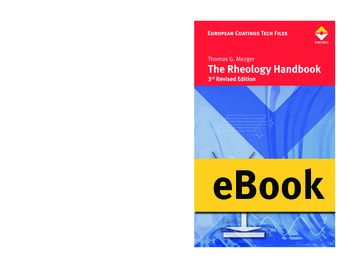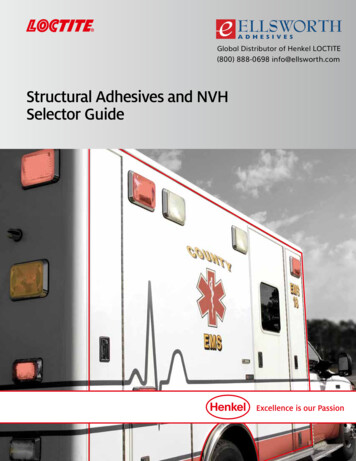
Transcription
Additives for Adhesivesand SealantsAdditives for top performance
Portfolio of BASF Additive Product FormsVarious products are offered in different forms,enabling better handling and different waysof processing for customers.The abbreviations for liquid and solidproducts used in this guide are:Aqueous Dispersion (DW)Durable Dust Free Form (DD)Easy Dosage Form (ED)Free Flowing Form (FF)Powder (P)Table of contentsAdditives for adhesives and sealants3Polymer dispersion and emulsion adhesives4Waterborne adhesives6Table 1: Additive selection guide for waterborne adhesives, dispersions and emulsions9Tackifiers and natural polymers10Hot melt adhesives12Table 2: Additive selection guide for tackifier, natural polymers and hot melt adhesives14Solvent-based adhesives16Reactive adhesives (2-component system and radiation curing)17Sealants 18Table 3: Additive selection guide for solvent-based and reactive adhesives and sealants19Nomenclature 22Glossary 23
Additives for adhesivesand sealants3Additives for adhesivesand sealantsThe wide range of additives produced by BASF, the world’s leading chemicalcompany, includes performance and formulation additives for a huge numberof demanding adhesive and sealant applications.Performance additivesPerformance additives such as light stabilizers and antioxidantsprotect the finished products from oxygen-radical and thermalrelated degradation. Manufacturers of adhesives and sealantscan choose from a variety of additives from our comprehensiverange that best meet their specific requirements.We are constantly improving our portfolio by developing newtechnologies for innovative processes, more sustainable innovative solutions and high-performance additives. This way,we help our customers improve the efficiency, durability andappearance of their products.Formulation additivesBASF is a key supplier of formulation additives for the adhesiveand sealant industry. These unique raw materials help enableperformance-driven products which meet the latest and moststringent environmental regulations. Our portfolio comprises abroad technology base of dispersing agents, wetting and surface modifiers, defoamers, rheology modifiers and film-formingagents.Sub-industry and technology segmentationThe segmentation of the sub-industries and technologies(i.e. product categories and market segments) in this brochureis in accordance with the ‘The FEICA-ASC Adhesives & Sealants Classifications Manual 2008’. The classification manualdefines the market segments and the product categoriesof adhesives and sealants mainly used in Europe and the US.Where possible, segments have been grouped for better overview of the technology. Each product category in this brochurefeatures a technology highlight that describes one or two mainadditive classes applicable to each category. Together theybuild a complete description of the additive technologies inadhesive and sealant use. The grouping in product categoriesdoes not imply that other additives are not applicable to thismarket segment but merely functions as a guideline for focusing the technology.AdhesivesAn adhesive is a compound that has the purpose of bondingtwo items together. Adhesive is a general term and includesamong others types of materials such as cement, glue, mucilage and paste. All of these terms are used interchangeably.Adhesives can be formulated based on a variety of differentchemistries either natural or synthetic based. Structural adhesives can be extremely strong, and are becoming increasingly important in modern light weight construction and a variety of other industries.The strength of an attachment or adhesive depends on manyfactors. Adhesion may occur either by mechanical means,in which the adhesive works its way into small pores of thesubstrate or by one of several mechanisms: An actual chemical bond occurs between adhesive andsubstrate. Electrostatic forces as in static electricity, hold the substances together. Van der Waals forces between molecules. Moisture-aided diffusion of the glue into the substrate,followed by hardening.11The FEICA-ASC Adhesives & Sealants Classifications Manual 2008
4Polymer dispersion and emulsion adhesivesFOAMASTER , RHEOVIS Polymer dispersionand emulsion adhesivesFOAMASTER , RHEOVIS Dispersions can be obtained from several chemistries such as polyacrylates,polyurethanes (PUD), polyvinylacetate (PVAC), ethylvinylacetate (EVA) polymers,rubbers (SBR) and many more. Adhesive applications include pressure sensitiveadhesives (PSA), office and packaging tapes, tapes for wrapping pipes, wiresand cables, masking tapes and diaper tabs.This is the largest class of adhesives. Dispersions can beobtained from a variety of chemistries, both thermosetting andair-drying. Typical examples of these classes of adhesivesare pressure-sensitive adhesives, adhesive tapes and overlayadhesives.With its water-based dispersions for adhesives, BASF alreadyoffers new options to the packaging industry. These are environmentally friendly and approved for food packaging. Inaddition, they can make an essential contribution to the optimization of production processes: laminates based on waterbased adhesives can immediately be processed and, thus,help reduce costs.With high-quality products and innovative system solutions,BASF provides an ideal combination that is both environmentally friendly and at the same time economical.Pressure sensitive adhesivesA pressure sensitive adhesive is a sub class of the general termadhesive which in dry form are permanently tacky at room temperature. They firmly adhere to a variety of dissimilar surfacesupon mere contact without the need of more than finger orhand pressure.Figure 1 Dispersions of acrylicbinder systems in water are alsocalled latex because of theirnatural rubber-like appearance.Figure 2 Microscopic picture of latexparticles.These require no activation by water, solvent or heat in order toform a strong adhesive force toward such materials as paper,plastic, glass, wood, cement and metals. They have a sufficiently cohesive force and elastic nature such that, despitetheir extensive tackiness, they can be handled with fingers andremoved from smooth surfaces without leaving a residue.2The FEICA-AASC Adhesives & Sealants Classifications Manual 2008
Polymer dispersion and emulsion adhesivesFOAMASTER , RHEOVIS Rheology modifiersFoam formation and defoamingRheology modifiers enable formulators to adjust the flowbehavior of adhesives. Adhesive formulators benefit fromimproved viscosity and application characteristics. The sagresistance of an adhesive is improved by a rapid but controlledviscosity increase after application.Foam is defined as a fine distribution of gas in a liquid phase.Almost all water-based dispersions foam during stirring andagitation as the dispersant is normally foam-stabilizing. Pureliquids, in contrast, do not foam.During transport and storage of the adhesive dispersion, therheology modifiers prevent sedimentation of the fillers withina formulation. Dispersing agents are used to wet and stabilizepigments and other particles within adhesive formulations.For formulators they represent an essential component as theyprovide viscosity stability and prevent sagging.Figure 3 Newtonian vs. non-newtonian effective viscosity comparison5Defoamers are low surface tension liquids which have thefollowing three properties: Insoluble or partially soluble in the medium to be defoamed Positive entering coefficient (for entering the lamella) Positive spreading coefficient (in the lamella)The selective incompatibility of the defoamer is determinedby the solubility parameter (Hansen/Hildebrand).DefoamersEffective viscosity Defoamers are used to inhibit the build-up of foam and reducefoam or trapped air by causing the bubbles to burst and release the air. Defoamers can be generally divided into the following subgroups: Silicone-free Silicone-containingDefoamers suppress and destroy foam and its negative effectsprior to and during application. By removing or inhibiting airbubbles, they act as important process aids throughout theadhesive production as well as the application process. Duringapplication the build-up of foam has to be prevented to ensurean optimum surface without any remaining bubbles or othersurface defects.shear rate Newtonian fluidShear-thinning fluidAt a glance Broad portfolio of synthetic rheology modifiers, includingnon-ionic associative (HEUR/HMPE), anionic associative(HASE) and non-associative thickener (ASE) technologies Focus on water-based systems with highly effective productsthat provide additional functionality such as wetting properties and health or environmental aspects (free of VOC, odour,APEO and heavy metals)Figure 4 Defoamers must have a lower surface tension than the surfactant,leading to an opposite Marangoni effect, i.e. fast thinning and collapse ofthe lamella.DefoamersThe Rheovis AS range (ASE – Alkali-Swellable Emulsions)provides shear-thinning rheology to give good suspendingpower and sag resistance, but low high-shear viscosity forease of application. This behaviour gives these products highadded value in formulations that are applied through rollerapplications, for example.The Rheovis HS range (HASE – Hydrophobically modifiedAlkali- Swellable Emulsions) offers less shear-thinning thanRheovis AS or more Newtonian rheology (shear independentviscosity). This provides the best levelling for gloss systemswhile avoiding spattering problems.Abbreviations:HASE hydrophobic modified alkali-swellable emulsionsASE alkali-swellable emulsionsHEUR hydrophobic-modified polyurethaneHMPE hydrophobic-modified polyetherEnteringSpreadingFast thinningBursting
6Waterborne AdhesivesHYDROPALAT , DISPEX Waterborne adhesivesHYDROPALAT , DISPEX The main polymers used to formulate waterborne adhesives are polyvinylalcohol (PVA), polyvinylpyrolidone (PVP) and cellulose ethers. Adhesive applicationsinclude packaging, retail consumer, construction and glue sticks.Waterborne adhesives are based on water-soluble polymers,in contrast to dispersion and emulsion technology that is usedto make originally non-water-soluble polymers compatible withwater. Water-soluble polymers are often combined with dispersions and emulsions as the common carrier is water.Water-based adhesives are an environmentally friendly andefficient alternative to solvent-based and solvent-free adhesives. Their main applications are present in all leadingend-user markets such as construction, packaging and alsopressure-sensitive adhesive labels.Waterborne adhesives and sealants can benefit from wettingagents, dispersants and our viscosity and rheology controlproduct lines, as well as defoamers and biocidal control duringmanufacture.Substrate wettingWater is a liquid that has a particularly high surface tension.Hence, under normal conditions, waterborne formulations needa substrate wetting additive to reduce the surface tension ofthe adhesive and sealant, preventing surface defects during theapplication and improving the levelling properties of the adhesive films and sealants.DispersionThe formation of stable dispersions is possibly the most timeand energy-consuming portion of the adhesive and sealantproduction process. This is due to the different surface tensionbetween the liquids (e.g. resin, solvents) and the solids (e.g.fillers, additives).A dispersing additive is necessary to generate a stable formulation and provide storage stability, thereby eliminating viscosity change and phase separation. The dispersants deflocculatesolids and thus significantly reduce adhesive viscosity. As aresult of this effect, solid loading can be increased accordingly.BASF offers a variety of polyacrylate dispersants.
Waterborne AdhesivesHYDROPALAT , DISPEX Dispersing agentsDispersing agents are used to wet and stabilize pigments andother particles within adhesive and sealant formulations. Forformulators they represent an essential component as theyprovide viscosity stability and prevent sagging.DISPEX dispersants are narrowly defined dispersants basedon acrylic chemistry. This is achieved via award-winningControlled Free Radical Polymerization (CFRP) technology,which allows for higher efficiency and broader compatibilityand creates optimal rheology.At a glance:Novel Encapsulated Additive Technology (NEAT) for performance light stabilizers is designed for water-based adhesiveand sealant applications. The NEAT-based preparations exhibitexcellent long-term storage stability without any sedimentationor phase separation in their delivery form.Key properties of the NEAT family: light stabilizer is “encapsulated” / dissolved in acrylic matrix particle size D50 150 nm active content of 20 % to 40 % (product-specific) total solids around 40 % to 50 % (product-specific)Their narrow molecular weight distributions provide optimumdispersion efficiency, translating into maximum performance atthe lowest possible formulation cost.Figure 5 Dispersion mechanism: example based on electrostatic and steric repulsion caused by the surfactantelectrostatic7steric
8Additive selection guideWaterborne adhesives, dispersions and emulsionsPrimary phenolic antioxidantünnnDispex AA S760liq.Solution of a sodium salt of an acrylic polymer in waterDispex AA 4030liq.Ammonium polyacrylate (co-)polymerDispex AA 4040liq.Ammonium salt of acrylic polymerDispex AA 4140liq.Sodium salt of acrylic polymerDispex CX 4240liq.Ammonium salt of acrylic polymerDispex CX 4340liq.Sodium salt of acrylic polymerDispex CX 4910sol.Sodium salt of acrylic polymerDispex Ultra FA 4404liq.Dispex Ultra FA 4420liq.FAMEFatty acid modified polyesterDispex Ultra FA 4425liq.FAMEFatty acid modified polyesterDispex Ultra FA 4430liq.Non-ionic fatty alcohol ethoxylateDispex Ultra FA 4431liq.Aliphatic polyether with acidic groupsnPartially neutralized chelating agentDispex Ultra FA 4437liq.Modified natural oilDispex Ultra FA 4480liq.Monofunctional oleo alkylenoxide block copolymerDispex Ultra PA 4560liq.High-molecular polyacrylatennnnnnnnnnnnnnnnnnnDefoamersFoamaster MO 2108liq.Proprietary organic blendünnnnnnnFoamaster MO 2110liq.Proprietary organic blendünnnnnnnFoamaster MO 2111liq.Proprietary hydrophobic blendünnnnnnnFoamaster MO 2134liq.Mineral-oil-based defoamerFoamaster MO 2135liq.Proprietary blend of oil and silica derivativesüFoamaster MO 2172liq.Proprietary blend of oils and silica derivativesüFoamaster MO NDWliq.Proprietary organic blendFoamaster NO 2306liq.Proprietary blend of oils and hydrophobesFoamaster WO 2323liq.White-oil-based defoamernFoamaster WO 2350liq.White-oil-based defoamernFoamStar ED 2526liq.Modified Star PB 2706liq.Polyether derivate of fatty acidnFoamStar PB 2770liq.Polymer defoamers / special defoamersnFoamStar PB 2922sol.Powder defoamersFoamStar SI 2210liq.Polysiloxane, polyol blendFoamStar SI 2213liq.Polysiloxane, polyol blendFoamStar SI 2227liq.Modified polydimethylsiloxane-based defoamersFoamStar SI 2250liq.Modified polydimethylsiloxaneFoamStar SI 2292liq.PolysiloxaneFoamStar ST 2441liq.Star polymer-based lluosePolyurethane (PUR, PUD)DWMethylcelluloseNatural rubber latex (waterborne)liq.Dispersing agentsCellulose ethersOther synthetic rubber latticesIRGANOX 245 DWPolyvinyl alcoholStyrene butadiene rubber (SBR)nProcessing & thermal stabilityWaterborneAcrylics and acrylic copolymersEthylene vinylacetate (EVA) co-polymersVinyl acetate polymers (PVAc)Polymer dispersions and emulsionsPot. food contactDescriptionClassification / chemistryPhys. formProductsTable 1 Additive selection guide for waterborne adhesives, dispersions and emulsions
Solution in water/isopropanol/propylene glycolnnRheovis PU 1280liq.HEURSolution in water/butyldiglycolnnASESpecial hydrophobic modified vinylpyrrolidone/vinylacetate liq.Cellulose ethersnRheovis PU 1270Polyvinyl alcoholnAcrylic thickener, water-in-oil emulsionWaterbornePolyurethane (PUR, PUD)Natural rubber latex (waterborne)Other synthetic rubber latticesStyrene butadiene rubber (SBR)Acrylics and acrylic copolymersEthylene vinylacetate (EVA) co-polymersVinyl acetate polymers (PVAc)Polymer dispersions and emulsionsAmmonia-based polyacrylateASEPot. food contactClassification / chemistryASEliq.DescriptionPhys. formsol.ProductsRheovis AS 1956Rheovis AS 1180Polyvinylpyrrolidone9Additive selection guideWaterborne adhesives, dispersions and emulsionsRheology modifiersRheovis AS 1420 liq.n Rheovis AS 1125liq.ASENon-associative thickener: anionic polyacrylatecopolymerRheovis AS 1130liq.ASEAnionic polyacrylate copolymernnnnRheovis AS 1135liq.ASEAnionic polyacrylate copolymernnnnRheovis AS 1188liq.ASEAnionic polyacrylate copolymernnnnRheovis AS 1920liq.ASEAnionic polyacrylate copolymernRheovis HS 1152liq.HASEAnionic polyacrylate copolymernnnnRheovis HS 1162liq.HASEPolyacrylateRheovis HS 1169liq.HASEAssociative thickener: anionic polyacrylate copolymer,hydrophobically modifiednnRheovis HS 1980liq.HASEPolyacrylatennnRheovis PU 1214liq.HEURAssociative thickenerünnnnnnnRheovis PU 1250liq.HEURAssociative thickenerünnnnnnnRheovis PU 1256liq.HEURAssociative thickenernnnn nnnWetting agents and surface modifiersHydropalat WE 3110liq.Alkoxylated surfactantsnHydropalat WE 3120liq.Alkoxylated surfactantsnHydropalat WE 3188liq.Non-ionic surfactant/emulsifierHydropalat WE 3240liq.Silicone surfactantHydropalat WE 3370liq.FluorpolyacrylatennnnnnnnnnHydropalat WE 3475liq.Dioctyl sulfosodiumsuccinateHydropalat WE 3485liq.SulfosuccinatesnnHydropalat WE 3486liq.SulfosuccinatesnnnnnnnnnnnLight stability / weather resistanceTINUVIN 99-DWliq.DWBenzotriazole (BTZ) for water-based systemsTINUVIN 123-DWliq.DWN-alkoxy HALSTINUVIN 292liq.HALSTINUVIN 384-2liq.BTZBenzotriazole (BTZ) multipurposeTINUVIN 400-DWliq.DWBlue-shifted hydroxyphenyltriazineTINUVIN 477-DWliq.DWRed-shifted hydroxyphenyltriazineTINUVIN 479-DWliq.DWHydroxyphenyltriazine suited for thin film applicationTINUVIN 1130liq.BTZTINUVIN 5151liq.BlendBTZ / N-alkyl HALSTINUVIN 5333-DWliq.BlendUVA / low alkaline HALSIRGAGUARD B 1000sol.MicrobialcontrolLoxanol CA 5308liq.Loxanol PL 5060Multipurpose HALS for various applicationsHydrophilic modified benzotriazoleOther additivesTINOPAL SFP TINOPAL NFW MELAPUR MC rangeOrganic antimicrobialnnCoalescingDicarbonic acid-diisobutyl esteragentsnnliq.PlasticizerPolypropylene glycol ilbene, water-soluble brightenernnliq.OpticalbrightenerSolution of an optical brigthener sodium saltnnsol.FlameretardantMelamine cyanurate flame retardantü Potential selection for Food Contact Approval. Please contact BASF to clarify exact registration statusnnnnnnnnnnnnnn preferred selectionpossible selectionnnnnn
10TACkiFierS And nATurAl PolyMerSIRGANOX , IRGAFOS , TINUVIN , IRGAGUARD Tackifiers and natural polymersirGAnoX , irGAFoS , Tinuvin , irGAGuArd This technology segment includes resin systems like casein, colophon resin,rosin ester and natural rubber. Examples of adhesive applications are hardpackaging and general hot melt adhesives.Natural-based adhesives undergo like any other synthetic polymers in adhesives and sealants induced discoloration as aresult of degradation. Natural rosin resins are even more proneto oxidation as there are several susceptible sites in the molecule that are predisposed to oxidation.Figure 6 Harvesting of natural rubber latex.Packaging MarketNatural-based adhesives are very popular and are growing involume. They will be used for many years to come in the packaging market. They are the adhesives of choice in hard packaging where water-removable paper labels are required.BASF offers additives to improve the performance of tackifiers,i.e. durability, prolonged open time, shorter reaction times,improved initial color of rosin esters and superior high temperature and storage stability. The use of the right tackifier resinhelps the formulators find the right balance between adhesionand cohesion properties.Technology focusAntioxidants play a key role in adhesive formulation. Theypreserve adhesion performance and rheological behaviorduring processing and aging, which are critical to guaranteethe high level of quality and performance needed in industrialbonding applications.Figure 7 Tackifiers build up to 30% of the hot melt formulation used in paperboard packaging.Antioxidants interrupt the degradation processAutoxidation may be initiated by heat, high energy radiation(UV light), mechanical stress, catalyst residues or throughreaction with other impurities. Free radicals (Figure 8) are generated which react rapidly with oxygen to form peroxy radicals.These peroxy radicals may further react with the polymerchains leading to the formation of hydroperoxides (ROOH).On exposure to heat or light, hydroperoxides decompose toyield more radicals that can reinitiate the cycle.The use of primary antioxidants such as Irganox suppressesthe formation of free radical species and hydroperoxides inpolymers both during storage and conversion. UV absorbersand hindered amine stabilizers such as Tinuvin and Chimassorb protect polymers from UV light-induced oxidation.
11Tackifiers and natural polymersIRGANOX , IRGAFOS , TINUVIN , IRGAGUARD Figure 8 Polymer degradation and stabilizationRH (Polymer)Energy,Catalyst residues,LightReacts withother RHReact with primary antioxidants(hindered phenols, hindered aminestabilizers) to yield inactiveproducts (ROH and H2O)Carbon centered radicals reactwith Lactone based stabilizersR OxygenCycle IICycle IROO ROO HO Energy,Catalyst residues,LightReacts with primary antioxidants (hinderedphenols, hindered amine stabilizers)Reacts withother RHR ROOHReacts with secondary antioxidants (phosphites,hydrolamines) to yield inactive productsIrganox and Irgafos antioxidants (AO) protect adhesives,sealants and fibers against thermal degradation during processing, production and service life. Irganox thereby represents a complete range of AO's based on sterically hinderedphenols or thioethers, as well as blends of different AO classes.Irgafos are so-called secondary AO process stabilizers basedon phosphite chemistry.Hindered Phenols can be used in a wide temperature range.The use of the secondary antioxidant is temperature dependent. Phosphites are largely used in high temperature processes such as compounding, while thiosynergists can also beused at lower temperatures.Figure 10 Effective use temperatures for the different classes of stabilizers.Primary Antioxidantsmainly acting in Cycle I of Figure 8 as chain-breaking antioxidants, are sterically hindered phenols (Figure 9). Primaryantioxidants react rapidly with peroxy radicals (ROO ) tobreak the cycle. Irganox 1010, Irganox 1076, Irganox 1098,Irganox 1135 and Irganox 245 are examples of primary antioxidants.Secondary Antioxidantsacting in Cycle II of Figure 8, react with hydro-peroxide (ROOH)to yield non-radical, non-reactive products and are thereforefrequently called hydro-peroxide decomposers. Secondaryantioxidants are particularly effective in synergistic combinationwith primary antioxidants. Typical secondary antioxidants arephosphites and thioethers.Long-TermThermal Stability (LTTS)Melt ProcessingStabilityHindered AminesThiosynergistsHindered PhenolsPhosphites050100150200SolidFigure 9 Types of antioxidantsHindered phenol AOPhosphite AOOHR2Thioether AOR2R1R3R3P(R)3-xOR1S(R)2xFor product details please see table 2 on page 14.250300 CMelt
12hoT MelT AdheSiveSIRGANOX , CHIMASSORB , TINUVIN , TINOPAL hot melt adhesivesirGAnoX , ChiMASSorB , Tinuvin , TinoPAl Hot melts can be based on polyacrylates, polyurethane (PU), polyolefins (PP, EP),ethylvinylacetate (EVA) polymers, polyamide (PA), saturated polyesters and styrene block polymers (SIS, SBS). Adhesive applications include packaging, bookbinding and product assembly.Hot melt adhesives are thermoplastics that are applied in amolten state. They achieve their bond strength on resolidification during cooling. Typically hot melt adhesives are formulatedwith about 30% tackifiers and other raw materials to tailor theprocessing. They are a very versatile group of adhesives whichare capable of bonding many different materials in major applications such as automotive, packaging, electrical / electronic,footwear and woodworking.Many of these applications require products that have goodadhesion to a variety of substrates, as well as medium to longterm aging performance. In order to match these requirements,hot melt adhesives have to be protected during the manufacturing, the application process and product lifecycle. There area number of hot melt adhesive technologies in use and antioxidants and light stabilizers play a key role in ensuring superiorproduct performance.Technology focusuv absorbersAccording to Lambert-Beer’s Law, the absorbance A, i.e.the filter effect of a UV absorber (UVA), is in linear relationshipto the optical filter concentration (c), the film thickness ( lightpath length) (d) and the extinction coefficient (ε). Thus the Lambert-Beer’s Law makes it possible to calculate/estimate thenecessary amount of UVA needed for proper light protection ata given film thickness (d). Increased (c) or (d) values result inincreased filter effect and therefore increased protectionagainst harmful UV radiation.Figure 13 Beer-Lambert LawTransmittance T decreases exponentially, absorbance A increasesby straight proportion with chromophore concentration c light path length or film thickness d extinction coefficient ε()1A log10 — ε c dTFigure 11 AcResin , a UV curablebinder system for hot meltapplication.Figure 12 Pressure sensitive adhesives are one of the main applications of hot melts.On the other hand, it means that the filter effect is stronglyinfluenced by the adhesive thickness; the thinner the adhesivethickness the more UVA is necessary. Hence, the UVA alone isnot sufficient to protect the very surface of an adhesive. Inconclusion they cannot effectively prevent the formation ofsurface defects as a result of photo degradation under exteriorconditions.For exterior conditions the combination of UVA and HALSprovides synergistic effects, allowing excellent protectionagainst surface defects and discolouration. For interior conditions the single use of UVA is largely sufficient in order toprevent both the fading of material properties as well as theyellowing of the adhesive.
hoT MelT AdheSiveSIRGANOX , CHIMASSORB , TINUVIN , TINOPAL 13Figure 14 The transmission is dependent of the film thickness at a defined UV absorber concentration.% Transmission02040608010002040T e –ɛ·c·d60d80uv absorberuv absorber requirements: Must absorb strongly in the UV Region (290 – 400 nm) Must have a sharp cut-off to visible light ( 400 nm) Must be photostable Must dissipate the photoexitation in a harmless wayFilm thickness / µm100optical brightenersSpecial types of UVA are optical brighteners. They convertUV light into the visible spectra. Optical brighteners are dyesworking by a fluorescent mechanism. They absorb light in theultraviolet region (usually 340 – 370 nm) of the electromagnetic spectrum, and emit light in the blue region (typically420 – 470 nm).Figure 15 Types of UV absorbersWith this special feature they are designed to brighten adhesives, sealants and fibers or to mask yellowing. Tinopal typescan also be used where fluorescence can provide a means ofdetecting film thickness, registration and identification, e.g. inadhesives and sealants as fluorescent tracer in-line assuranceinspections.HR2Benzophenone (BP)HOR1NNNR3R2Benzotriazole (BTZ)R1HOR2NNR2Figure 17 Hot melt adhesives for DIY use are largely based on EVA polymer.NR3R3Hydroxyphenyltrianzine (HPT)
14Additive Selection GuideTackifier, nat. polymers and hot melt adhesivesAcrylics and acrylic copolymersPolyurethane (PUR)Styrene block copolymers(e.g. SBS, SIS, SEBS)Polyester, saturatedPolyamide (PA)Ethylene vinyl acetate (EVA)Polyolefin (PE, PP, APP)Hot meltRosin esterPolypreneHydrocarbonsTackifierFood ContactDescriptionClassification / chemistryPhys. FormProductsTable 2 Additive selection guide for tackifier, natural polymers and hot melt adhesivesProcessing & thermal stabilityIRGAFOS 126sol.PSecondary antioxidant/phosphiteünnIRGAFOS 168sol.(ED) / FFSecondary antioxidant/phosphiteünnIRGANOX 1010sol.(ED) /FFPrimary phenolic antioxidantüIRGANOX 1035sol.FFPrimary phenolic antioxidantüIRGANOX 1076sol.(ED) / FDPrimary phenolic antioxidantüIRGANOX 1098sol.EDPrimary phenolic antioxidantIRGANOX 1330sol.PPrimary phenolic antioxidantIRGANOX 1425sol.FFCalcium phosphateüIRGANOX 1726sol.PPrimary phenolic antioxidantüIRGANOX 245sol.PPrimary phenolic antioxidantüIRGANOX 3114sol.PPrimary phenolic antioxidantüIRGANOX 565sol.PPrimary phenolic antioxidantüIRGANOX B 215sol. DD/ED/FF Blend of antioxidantsünnnnnIRGANOX B 225sol. DD/ED/FF Blend of antioxidantsünnnnnIRGANOX B 561sol.FFBlend of antioxidantsünnnnnIRGANOX B 612sol.PBlend of antioxidantsünnnnnüünnIRGANOX MD 1024sol.PMetal deactivator (Primary phenolicantioxidants)IRGANOX PS 800sol.FLSecondary antioxidant/thiosynergist nnnnnnnnnnnnliq.Unsaturated polyamide and acid ester saltsEfka FA 4665liq.High-molecular carboxylic acid/polysiloxane Efka FA 4642liq.Dispex Ultra FA 4420liq.FAMEFatty acid modified polyesterDispex Ultra FA 4425liq.FAMEFatty acid modified polyesterDispex Ultra FA innnnnnnnnAliphatic polyether with acidic groupsliq.nnDefoamersFoamStar SI 2280nnUnsaturated polyamide and acid ester saltsEfka PB 2020nnnDispersing agentsEfka FA 4644nWetting agents and surface modifiersEfka SL 3030liq.Modified polysiloxanesEfka SL 3034liq.Fluorocarbon modified polysiloxanesEfka SL 3035liq.Modified polysiloxanesEfka SL 3236liq.Modified polysiloxanesEfka FL 3277liq.F
The Rheovis HS range (HASE - Hydrophobically modified Alkali- Swellable Emulsions) offers less shear-thinning than Rheovis AS or more Newtonian rheology (shear independent viscosity). This provides the best levelling for gloss systems while avoiding spattering problems. Abbreviations: HASE hydrophobic modified alkali-swellable emulsions










